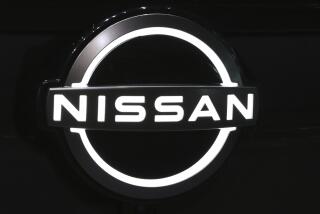Is Child Car Safety a Lesser Priority?
- Share via
Cadillac says in recent advertisements that its DeVille models have air bags that protect passengers who sit in the center of its front bench seats.
Since hardly anyone but children sit in center seats, Cadillac’s claim suggests two questions: Do other car models offer the same protection? And why doesn’t the government require that such seats have the same protection as the other front seats?
The disturbing answer, some critics say, is that the federal government puts a higher priority on adult safety than child safety in auto standards.
“The regulatory issues are driven by adult needs rather than the needs for kids,” says Chuck Hurley, vice president of the Insurance Institute for Highway Safety, a trade group. “The pattern is unmistakable.”
Clarence Ditlow, director of the advocacy group Center for Auto Safety, says, “It is a terrible, tragic oversight in general but particularly in the case of center-seat air bag protection.”
Such charges are disputed by Barry Felrice, deputy administrator at the National Highway Traffic Safety Administration, who cites such examples as child restraint seats and tougher school bus standards as two areas of stringent child safety regulations.
“Can we do more to improve child safety? Yes. We are upgrading our standards,” says Felrice. Current federal rules subject auto makers to exacting tests to ensure that occupants in the driver seat and the front passenger seat are provided head injury protection in frontal crashes. The level of protection is measured using electronically monitored dummies in test crashes.
Felrice says that while Cadillac is the only firm to publicly claim its air bags protect center seat occupants, most other cars with dual air bags also provide some level of protection, based on the opinion of his technical staff.
“I am not sure what Cadillac is saying is any different than what any other vehicle offers,” Felrice said.
GM says its claim is backed by tests not conducted originally for advertising purposes, but as part of the firm’s technical efforts that go far beyond federal government requirements.
Tom Barszcz, a GM air bag engineer, says two different size crash dummies in a center seat were subjected to five different crash tests. One set of tests involving an adult male dummy showed the air bags provided better protection than federal standards that apply to the right passenger seat. In the other set of tests involving a small female adult dummy, GM beat its own internal standards, since no government standards exist for females, Barszcz says.
The picture for air bags isn’t the only controversy involving child safety. Some safety advocates cite the lack of standards covering rear facing seats in station wagons, which are almost exclusively occupied by children. And the federal government is preparing to issue a rule that allows industry to make what critics regard as a cheap fix to a hazard posed by air bags to infants in rear facing seats.
Injuries have occurred when a fast inflating air bag thrusts an infant carrier seat back into the infant’s head. The new rule allows a switch that turns off the passenger air bag. Critics have lobbied unsuccessfully for a sensor that would detect the use of a rear facing seat and automatically disable the air bag.
Ditlow says bureaucrats and auto makers allowed such shortcuts because, “Kids don’t buy cars.” But Felrice says the technology for a sensor is not available. “We can’t mandate technology that isn’t there,” he says.
*
* Vartabedian cannot answer mail personally but will attempt to respond in this column to automotive questions of general interest. Do not telephone. Write to Your Wheels, 1875 I St. N.W. 1100, Washington, D.C. 20006.







